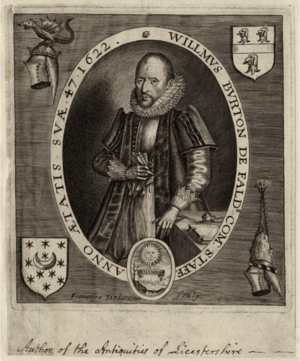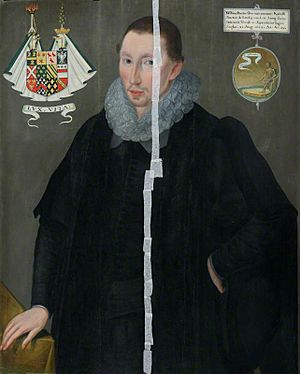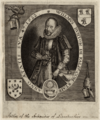William Burton (antiquary, died 1645) facts for kids
William Burton (born August 24, 1575 – died April 6, 1645) was an English antiquarian. An antiquarian is someone who studies old things, like ancient objects, places, and history. Burton is best known for writing the Description of Leicester Shire (1622). This was the very first history book about the county of Leicestershire to be published.
Contents
Early Life and Career
William Burton was born in Lindley, Leicestershire, on August 24, 1575. His father was Ralph Burton. William also had a younger brother, Robert Burton, who became a famous scholar.
When William was nine years old, he went to school in Nuneaton. Later, in 1591, he started studying at Brasenose College, Oxford. He earned his first degree there in 1594.
In 1593, William joined the Inner Temple. This was a place where people studied to become lawyers. He was part of a group of antiquarians there, including Sir John Ferne and Peter Manwood.
Life in Retirement
William became a lawyer in 1603. However, he soon retired because he wasn't very healthy. He moved to his estate in a village called Falde in Staffordshire.
William had many important friends. These included Sir Robert Cotton and William Somner, who were also interested in history. He also knew the famous writer Michael Drayton.
During the First English Civil War, William Burton supported the King. Because of this, he faced difficulties. He passed away at Falde on April 6, 1645. He was buried in the church at Hanbury.
William Burton's Writings
William Burton wrote a Latin play in 1596, but it was never published. In 1597, he published a translation of an ancient Greek story called Cleitophon and Leucippe. He dedicated this book to the Earl of Southampton.
Burton could speak Spanish and Italian. He also studied emblem-writers, who created books with pictures and symbolic meanings. But his main interests were heraldry (the study of family symbols and coats of arms) and topography (the study and mapping of places). In 1602, he updated a map of Leicestershire made by Christopher Saxton.
The Description of Leicester Shire
William Burton started working on his most famous book, the Description of Leicester Shire, around 1597. It was finally printed in 1622. He dedicated it to George Villiers, a powerful nobleman.
After the book was published, Burton spent many years adding new information and making corrections. He wanted to create a new, updated edition. In 1638, a copy of this new version was sent to London to be printed. However, the First English Civil War began, and the project had to be stopped. We don't know what happened to that manuscript.
Burton started working on another updated version in 1641. After he died, his son, Cassibelan, gave these materials to Walter Chetwynd. These included a copy of the Description with many handwritten notes by Burton. They also included other manuscripts with more additions and changes. These important documents are now kept in the Staffordshire Record Office.
In 1798, a scholar named Shaw found one of these copies. Later, John Nichols used this information in his own large history books about Leicestershire. In 1777, a new edition of Burton's Description was published.
Other Contributions
William Dugdale, another famous antiquarian, said that William Burton helped him a lot with his own work. In 1612, a man named Thomas Purefoy gave Burton the original handwritten notes of John Leland's Collectanea. Leland was an early English historian.
Some people thought Burton added too much to Leland's work. But Thomas Hearne, another scholar, disagreed. In 1631, Burton had parts of Leland's Itinerary copied. The next year, he gave five handwritten volumes of Leland's work to the Bodleian Library at Oxford University.
Among the other handwritten works Burton left behind were:
- Antiquitates de Lindley: This was a study of Lindley, his hometown. It is now in the British Library.
- Antiquitates de Dadlington Manerio, com. Leic.: This was about the Dadlington Manor in Leicestershire.
- Antiquitates de Falde: This was about Falde, where he lived in retirement. It is also in the British Library.
- Notes for a history of Thedingworth.
Family Life
In 1607, William Burton married Jane Adderley. She was the daughter of Humfrey Adderley from Weddington, Warwickshire. They had one son together, named Cassibelan Burton.
Images for kids
-
Portrait of Burton, engraved by Francis Delaram. This engraving was used as a frontispiece to Burton's Description of Leicester Shire (1622).
-
Portrait attributed to William Segar, Society of Antiquaries of London





